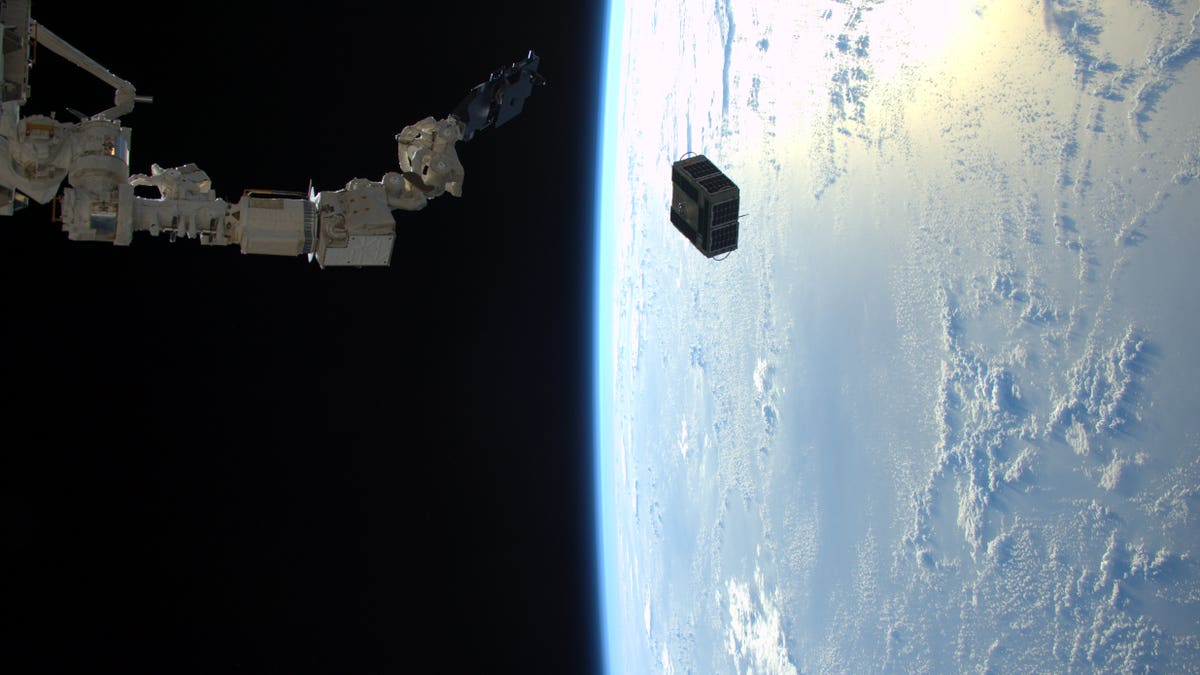
The robotic arm in Japan's Kibo laboratory successfully deploys two combined satellites from Texas universities from the International Space Station, January 29, 2016. (REUTERS/NASA/Tim Peake/Handout)
Good fences make good neighbors, which is why the United States is building a space fence.
But the first thing to understand about the space fence is that it’s not actually a fence — it’s radar. And when it’s operational, pulsing up from an atoll in the Pacific, it will be able to track objects in space that are softball-sized, the Air Force says.
The purpose? To keep track of space debris, but also for deterrence, in order to keep U.S. assets in space safe from other powers that might want to attack them.
‘Bubble of Uncertainty’
There are 23,000 human-made objects orbiting the Earth, and about 1,300 of those are active satellites, according to Capt. Nicholas Mercurio, the director of public affairs for the Joint Functional Component Command for Space at Vandenberg Air Force Base in California. Existing systems track those objects, and are able to detect pieces of debris that are about four inches long in low-Earth orbit, he said.
Related: Could space research offer new hope for cancer patients?
“The new space fence will have much greater sensitivity, allowing it to detect and track and measure an object the size of a softball, orbiting more than 1,200 miles in space,” Mercurio told FoxNews.com. The new system— which will detect objects in space as they pass through what Mercurio described as a “curtain of radar”— will be able to track objects that are about two inches long.
When tracking objects, the Air Force uses the term “bubble of uncertainty” to describe a satellite’s projected location when it nears another object, and if a satellite’s bubble overlaps with the bubble of a piece of debris, then that’s what the Air Force calls a “conjunction.” The new space fence, since it promises to be more accurate, will shrink those uncertainty bubbles, Mercurio said.
Brian Weeden, the technical advisor for the Secure World Foundation, has written a lengthy analysis of the space fence.
Related: Three million photos and counting: Space station crew takes milestone snapshots
“We know through some scientific work, that there’s roughly half a million pieces of space debris larger than let’s say half an inch, but smaller than four inches, that’s there but we can’t track it right now,” Weeden told FoxNews.com “So one of the big reasons why the military is investing in the new space fence is to track those objects.”
This isn’t the first space fence. The original one was a radar system based in the continental United States, which the Air Force shut down in 2013.
“The decision itself was interesting in that it was wrapped up in the whole sequestration discussion. That was the rationale that the Air Force Space Command gave,” Weeden said. But that was just "part of the story," he said. “I think there’s a case to be made that shutting down the original was kind of part of the budget justification for the new one.”
“I think tracking more of the space debris, and particularly the smaller space debris objects, is a very good goal,” Weeden added. “I think there are a lot of questions, though, about whether this really is the most bang for the buck.”
Deterrence

Space fence testing facility in New Jersey. (Lockheed Martin)
But the space fence isn’t intended to just track debris.
“There’s a reason why the military is doing this,” Weeden said. “A big part of that is they are worried about not only debris collisions with military satellites, but potential adversaries using small space objects to try and attack satellites.”
Weeden highlighted the development of cube satellites, small objects with edges that might be about four inches long. There’s a sense of concern that these small devices could potentially be used to attack bigger satellites, he said.
Related: 1917 glass plate offers oldest evidence of exoplanetary system
“No one would benefit from a war which extends to the space domain,” Mercurio said, citing space’s centrality in everyday life. “With that in mind, the space situational awareness capacity of the [Joint Space Operations Center] has a deterrent aspect to it, because we are able to identify, characterize, [and] attribute actions in space.”
The space fence is part of that, he said.
Omar Lamrani, a senior military analyst for Stratfor, an intelligence firm, said that the space fence could help the U.S. move a satellite away from another satellite that could harm it, and could also help attribute aggressive actions if they occur.
“The first part of deterrence is attribution,” Lamrani told FoxNews.com. In other words, if a country like Russia or China knows that the United States would be able to attribute a hostile action in space, they are less likely to do it.
As for his opinion of the space fence? “There’s what they say it’s capable of, which is really, really, impressive on paper,” Lamrani said. “If that is the case, then that’s really strong technology.”
The space fence radar system is being built by Lockheed Martin, and will be based on the island of Kwajalein in the Marshall Islands in the North Pacific. Testing has started in New Jersey, and last month, General Dynamics reported that a part of the space fence facility it had built, weighing 700,000 pounds, was ready for shipment to Kwajalein.
Mercurio said that it will begin its operations at the end of 2018.
Follow Rob Verger on Twitter: @robverger




















